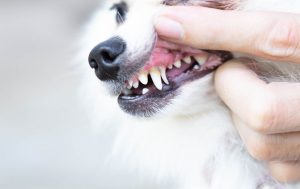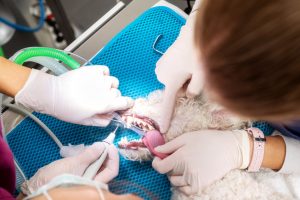Pet Dental Care
 A complete physical examination by one of our doctors at Longwood Veterinary Center always includes a pet dental care evaluation of your pet’s mouth. At some point in time after a routine visit, you are going to hear one of our doctors recommend a dental cleaning and complete evaluation of your pet’s mouth under anesthesia.
A complete physical examination by one of our doctors at Longwood Veterinary Center always includes a pet dental care evaluation of your pet’s mouth. At some point in time after a routine visit, you are going to hear one of our doctors recommend a dental cleaning and complete evaluation of your pet’s mouth under anesthesia.
Anything having to do with anesthesia can, understandably, make a pet owner feel a bit nervous. Most people have more than a few questions about why anesthesia is necessary and what the health benefits of a dental cleaning and evaluation are. We hope this information helps you understand the process and undeniable benefits of this procedure.
Why can’t my pet be awake for their dental cleaning and radiographs?
In veterinary medicine, it is very difficult to completely examine the mouth of an awake animal and provide adequate pet dental care. Pets tend to guard their mouths and, in general, do not appreciate us poking and prodding their teeth, gums, and tongue. Not only can an examination be difficult, or extremely limited in our pet friends, obtaining oral radiographs, scaling, polishing, and using the dental probe is impossible in an awake animal.
To put it into perspective, think about how difficult it is for us humans to sit in our dentist’s chair for x-rays suffering through the tedious task of scaling, probing and polishing every inch of our teeth for what seems like hours. To do a good job, our dental hygienist implores us to sit still, relax and be patient. Not so easily accomplished in a dog or cat. Thus, general anesthesia is necessary.
Is general anesthesia safe?
Yes. In pre-screened, healthy animals with no serious pre-existing health issues, general anesthesia is a safe procedure. All pets who undergo anesthesia have routine blood work performed prior. A doctor has evaluated that bloodwork and made a decision as to whether any obvious health concerns have been revealed that would make anesthesia unsafe. Before anesthesia, including the morning of the procedure, a doctor performs a complete physical examination that includes listening to the heart and lungs.
If the examination reveals a heart murmur, arrhythmia, or abnormal lung sounds further investigation including chest films and consultation with a veterinary cardiologist is recommended. The dental procedure will only be performed if the bloodwork, a physical examination, and cardiac consultation (when warranted) are normal and the pet is deemed healthy.
 Does it really matter if my pet has clean teeth?
Does it really matter if my pet has clean teeth?
Having clean, polished teeth is a wonderful side effect of an oral evaluation and cleaning under anesthesia. However, this is not the most important reason for going ahead with the procedure. Oral health in pets is as important as it is in people but is often overlooked. Severe dental disease in pets is a chronic source of inflammation in the body. Diseased mouths not only harbor infection and bacteria but are a source of near-constant pain.
Bacteria in plaque will find its way underneath the gum line, causing first moderate inflammation of the gums (gingivitis) that progresses over time to periodontal disease. Advanced periodontal disease is coupled with infection of the bone, ligaments, and structures surrounding the teeth. The infection leads to severe bone loss and loose teeth that are prone to excess motion and fracture. Painful abscesses can form around the root tip as well. As any person who has had a tooth root abscess knows, these teeth are extremely uncomfortable. Remember, pets are masters at hiding pain. Just because they seem to have little difficulty chewing, eating, or going about their daily lives, it doesn’t mean they are not chronically uncomfortable.
Trust Longwood Vet with Your Pet Dental Care
As was discussed earlier, it is very difficult to examine the mouth of an awake pet. An evaluation under anesthesia allows the veterinarian and veterinary dental hygienist to also look at the gums, tongue, and other oral structures to rule out the presence of masses, foreign bodies, lacerations, or other abnormalities. Performing biopsies, suturing lacerations, and removing foreign material from the oral cavity is often necessary for our veterinary patients.
Most of us would agree, keeping our pets comfortable is of utmost importance. Hopefully Part 1 of our dental health series helps shed some light on how we perform and why we recommend dental procedures in pets. Part 2 will walk us through the particulars of taking radiographs, when and why extractions are necessary and an explanation of the costs involved in providing a quality dental service to our Longwood Veterinary Center patients. As always, if you have any pet dental care questions for us, just get in touch!
